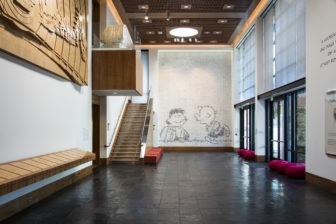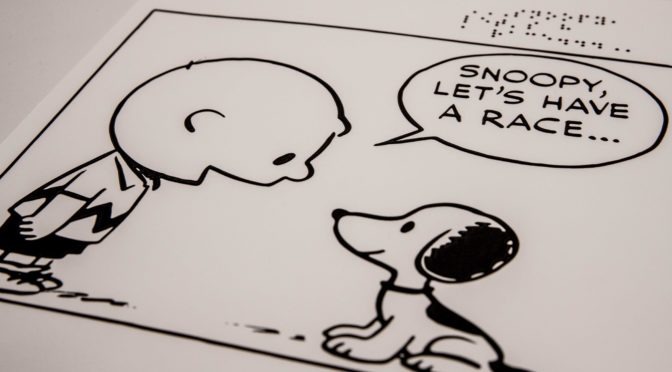Charlie Brown and Snoopy are some of the most well-known characters of all time. By the time Peanuts’ creator Charles Schulz retired in December 1999, the comic strip had run for 50 years and been syndicated in over 2,600 newspapers worldwide, with book collections translated into more than 25 languages.
Peanuts is universally human in its sarcastic, nostalgic, bittersweet, silly, realist and occasionally fanciful humor. Schulz filtered his own dark irreverence into the trials and tribulations of Charlie Brown, Snoopy, Linus, Lucy, and the rest of the characters many of us came to know and love. It is, fundamentally, a story of a dream not quite achieved — and how, even so, another day will come to pass.

It’s for its universality and renown that the Charles M. Schulz Museum in Santa Rosa remains dedicated to making Peanuts accessible to all — including the blind and low vision community. Just this month, the LightHouse MAD Lab worked with the Schulz Museum to create a tactile representation of a four-panel Peanuts strip first published on July 31, 1951.
The museum’s School and Youth Programs Coordinator Monica Hernandez initiated the collaboration after learning more about museum accessibility while studying at SF State, and to prepare for the museum’s second Accessible Tours Day, which will be held on September 23, 2018.
“As I understand it, often people with disabilities are told that they’re too expensive, that it’s too much trouble or effort to take on a project like this,” says Hernandez. “That’s not what we’re about. We try to do our best with accessibility at the museum.”
“The comic strip and Peanuts in general are such an accessible and universal topic,” she continues. “People from all over the world love and know and understand Snoopy. Schulz put a little bit of himself into every character, and we all relate to at least one of them — whether it’s the innocent and gullible Charlie Brown or Peppermint Patty because she’s good at sports.”
The strip in question was chosen deliberately in hopes of demonstrating the evolution of the (arguably) most beloved characters — Charlie Brown and Snoopy. An earlier depiction, the strip shows Snoopy running on all four legs (he later evolved to his more recognizable upright, two-legged stance) and a youthful, oblong-headed Charlie (into the 90s, his neck and torso elongated and he adopted a wobbly, anxious mouth).
Charlie Brown challenges Snoopy to a race: “Snoopy, let’s have a race!” When Snoopy sets off, Charlie Brown stays put: “Ah, now I can eat this candy in peace!”
It’s a sweet a simple strip that offers some insight into the very beginnings of the Peanuts’ long and storied history and evolution. MAD Lab’s 10″ X 11″ Direct UV prints used the simplicity of Schulz’s bold lines to their advantage — one set of the ensuing tactile representations feature one-to-one raised lines and braille descriptions. A second set used used various fills, textures and relief heights to differentiate between the overlapping figures of Charlie Brown and Snoopy.
MAD Lab’s Senior Designer Naomi Rosenberg found the project to be a great exercise in translation: “We’re trying to stay as true to the original comic strip as possible, but translate it in a way that makes sense to the touch,” she says. “Pairing tactiles with succinct descriptions provided by the museum was a great approach. They really had the right intentions and a good understanding of the needs of blind users. There’s something exciting about working with a museum that sees a lot of kids and school groups coming through. The project might have an impact on exposing kids to tactiles early on.”
Hernandez was very happy with the project’s outcome and looks forward to seeing how the community receives the strip during Accessible Tours Day.
“It was so great working with the MAD Lab on this project and learning from their expertise,” says Hernandez. “They were very positive and warm throughout the process and openly offered suggestions. The project will go a long way for increasing the Museum’s accessibility and starting further conversations and projects around access.”
Accessibility at the Charles M. Schulz Museum
Schulz himself initiated accessible projects including a braille version of “Happiness is a Warm Puppy”, which can be viewed at the museum upon request.
MAD Lab’s tactile comic strip is also on view by request and will be available for viewing the museum’s Accessible Tours Day on Sunday, September 23 from 10 a.m. to 1 p.m. Special tours will be available for deaf, hard of hearing and low vision visitors led by trained docents with sign-language interpreters throughout the morning.
To reserve your tour time in advance call 707-284-1263 or email monica@schulzmuseum.org. Tours are included with regular museum admission and the museum also offers large-print booklets of exhibition text at the front desk for low vision visitors.
Contact the MAD Lab
To contract for custom tactile maps of your neighborhood, workplace or university or propose a museum project like this one, visit https://lighthouse-sf.org/braille-and-accessible-design/.

